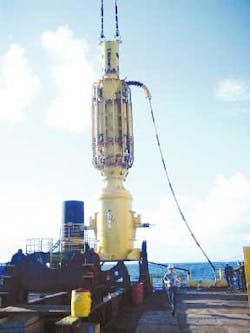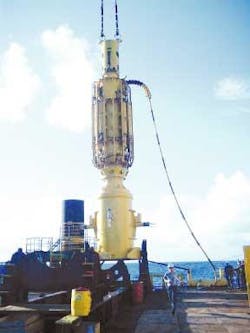Menck seeks to double depth record for underwater pile-driving
Driving piles to fix platforms to the seabed has been routine for decades in conventional water depths. In shallow-water fields, where the piles are driven through the platform legs from the surface, the entire range of pile-driving equipment is applied, including steam and diesel-driven hammers.
null
However, when field development moved to water depths of 500 m and beyond, changes in platform designs required the piles to be driven underwater. This led to development of the hydraulically driven hammer that is today used widely for pile driving operations. The hammer is powered by a hydraulic power pack onboard the installation vessel through a bundle comprising hydraulic hoses and an air hose.
Menck, based in Kaltenkirchen, near Hamburg, anticipated current requirements in 1980. An engineering team was established to solve problems associated with the surface power pack and all hoses connected to the hammer, as the equipment became too large and heavy for safe handling. Also, the large volume of oil needed for such operations was considered unacceptable in terms of safety and the environment.
In 1989, a test pile was driven with the newly developed system in 1,000-m water depth. The system consisted of a modified MHU 400T hammer with an integrated Menck underwater girdle power pack (MUP) built around the hammer, using only a small amount of hydraulic oil and an umbilical to provide electric power and air. Since the test operation, Menck has performed 25 installations on TLPs and spar platforms in the Gulf of Mexico, West Africa, and elsewhere, in water depths ranging from 500 to1,500 m.
The deepwater pile-driving system today comprises an underwater power pack and a choice of hydraulic impact hammers with driving energy ranging from 200-1,000 kJ. The electric-hydraulic MUP can function irrespective of the water depth, due to its in-built pressure equalization. All functions provided conventionally by hoses, power and communications cables are performed in the single umbilical, currently available in lengths of up to 2,400 m.
null
With the hammer being integrated into the power pack, hydraulic lines are short, and energy transfer losses become negligible, the company claims. This combination provides dimensional and weight control of the power pack, which in turn allows a wide range of installation vessels to handle the system.
System handling is designed to be straightforward, including upending on deck and stabbing onto pre-set piles in ultra-deepwater. Mooring piles can also be installed by attaching hammer and pile on the vessel's deck, then lowering the assembly to the seabed.
The hammer-lifting appliances are des-igned to carry piles of up to 400 tonnes. The patented connection between hammer and piles can be released easily by an ROV before pile-driving gets under way. According to Menck, the wide range of hammer sizes available with the power packs allows underwater driving of piles as small as conductors up to the largest TLP foundation piles.
Last year, an MHU 500T MUP pile-driving system was selected for ExxonMobil's Kiz-omba A wellhead platform offshore Angola, West Africa's first TLP. The platform is moored by eight 84-in. OD piles in 1,190 m of water. As the installation vessel Seaway Polaris was equipped with two cranes, the project team decided to maintain the hammer close to the seabed to avoid delaying installation operations. One crane lowered the piling hammer to the seabed while the vessel handled and stabbed the piles with the second crane. After each pile was stabbed, the hammer drove the pile to target penetration at pre-determined energy levels.
Also in 2003, Menck set a new depth record of 1,310 m for underwater pile driving on the Marco Polo TLP in the GoM. The same model, an MHU 500 hammer, extended the record early this year on ConocoPhillips' Magnolia TLP, when Sai-pem used it to install eight 96-in.-diameter, 100-m-long foundation piles in 1,425 m of water. Two clusters of piles were driven to a pre-set installation tolerance of less than 1° from the vertical.
Work is now under way to stretch the record to 2,500 m through installation of a long jumper between the hammer and the main umbilical for a project in the GoM. The water depth is still within the system's rating. Continuing development of the MUP includes a program to enhance the control system, increase accuracy, and to extend the depth rating of the deepwater version for future operations in 3,000 m and beyond.


